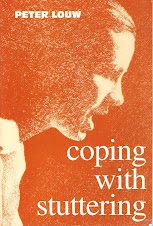“What I consider to be severe stuttering has nothing at all
to do with the magnitude of the viewable struggle, but is associated with the
intensity of the patient’s stress level and
the firmness and frequency of the laryngospasm. In my experience, severe
stutterers constitute no more than about 12 percent of the patients.”
This quote, and particularly the emphasised section, from Dr
Martin Schwartz’s first book, Stuttering Solved, has always fascinated me and
it may be a good idea to once again give a summary of Dr Schwartz’s view of
severe stuttering.
The traditional, popular view of a severe stutterer is a
person who stutters markedly and often. Dr Schwartz, however, believes that
this emphasis on overt struggle is misplaced. “Violent, overt struggling is
simply an individual response to the occurrence of a laryngospasm.” The
laryngospasm is an unnatural, tension-related “freezing” or “locking” of the
two vocal cords situated in the larynx. The vocal cords, when functioning
normally, are a crucial component in the production of normal speech. If they lock,
they make speech very difficult or impossible. Stuttering is an individual
response to this locking. Stuttering is what we do when we try to speak even
though our locking vocal cords make it very difficult to speak.With the Passive
Airflow speech technique, however, this laryngospasm is avoided or diminished
by letting a very slight amount of air slip out from the lips PRIOR to speaking.
Back to the above description of severe stuttering. Dr
Schwartz believes that severity depends on two factors:
( 1. The intensity of the stutterer’s stress levels and their response to speech difficulties. Some people are simply more stressed
than others and respond excessively to things, including to speech problems.
Stutterers with such a degree of stress very often do not possess the requisite
presence of mind required to apply fluency techniques. Clearly these people
should work on their stress management and on changing their attitude to their speech
and their listeners.
2. The frequency (number) and firmness of the
laryngospasm, rather than the intensity of the external struggle. With most
stutterers, a single application of the airflow technique at the beginning of
the sentence, combined with slowing the first syllable, will carry the client
through the entire sentence.
“But if the word or sound stress
within the sentence was high, or if the patient had an extremely high baseline
stress, the firmness of the closure might be so great that several airflows
would be required within each sentence.” This would be obtrusive, and for these
severe stutterers Dr Schwartz developed a type of breathy speaking where they
never firmly closed their vocal cords, but spoke with the cords perpetually
open, so that airflow was present not only before each sentence, but throughout
it as well. This was not an ideal solution, but better than nothing at all.
Personally
I believe that severe stuttering can also be viewed from other angles, for
instance the distribution of the disorder in the stutterer’s speech. The
stuttering of some fortunate people is limited to a few words or maybe a single
sound (read THIS for more details), whereas a few severe stutterers stutter violently in any speaking
situation and on nearly every word or sound. An additional factor may be the
extent to which the struggle behaviour has been established and reinforced, in
other words the strength of the conditioned reflexes.
I have always believed in the laryngospasm hypothesis,
probably because in my own experience of my stuttering I seem to feel a
tightness deep in my throat which makes speaking physically impossible. This,
of course, is not a scientific observation as the tightness could be the result
of other laryngeal muscles tightening. However I do urge people to try and
identify where exactly their original core source of stuttering lies. Lip
closures, tongue movements etc. seem to be simply efforts to overcome the core
of stuttering: the vocal cord locking or “freezing” deep within the larynx.







No comments:
Post a Comment